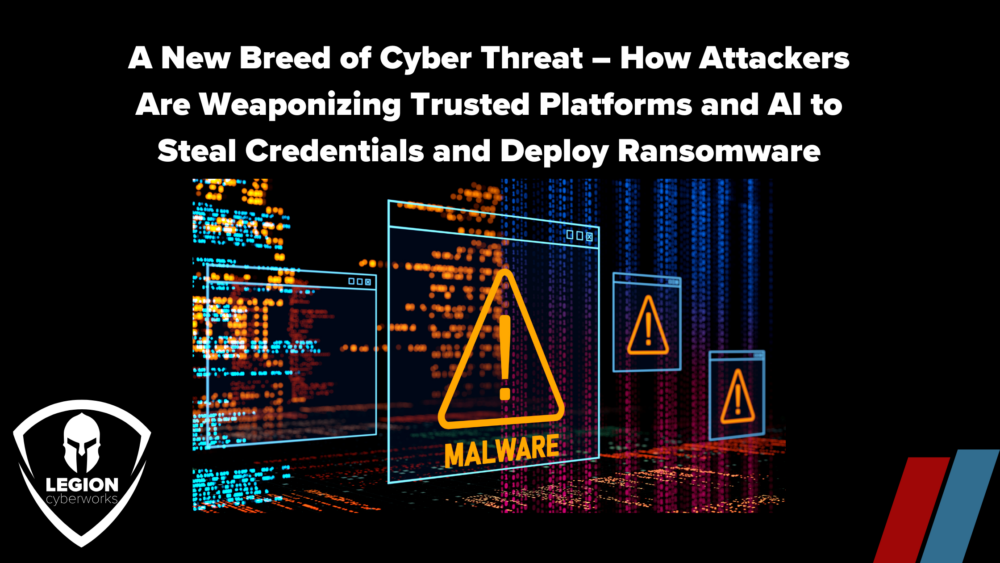At Legion Cyberworks, our mission is to shield organizations from the ever-evolving landscape of cyber threats. Today, we’re sounding the alarm on a dangerous convergence of attack techniques that’s exploiting trusted platforms like Microsoft 365, leveraging AI to craft hyper-realistic phishing lures, and bypassing two-factor authentication (2FA) to deliver ransomware and infostealers. CISOs, CEOs, CTOs, and cybersecurity practitioners—this is a wake-up call to understand and counter this sophisticated threat before it strikes your organization.
The Perfect Storm: Trusted Platforms, AI, and 2FA Bypasses
Cybercriminals are no longer relying on sketchy domains or blatant malware. They’re hiding in plain sight, abusing the trust we place in platforms like Microsoft 365 to launch attacks that are nearly impossible to detect. Here’s how they’re doing it:
- Hijacking Microsoft’s Trusted Infrastructure
Attackers are exploiting legitimate Microsoft 365 tenant accounts—either by compromising existing ones or spinning up new ones—to send phishing emails that originate from Microsoft’s own servers. These emails, often disguised as billing notifications or subscription alerts, pass all standard security checks (SPF, DKIM, DMARC) and land in your inbox looking like the real deal. Instead of malicious links, they trick users into calling fake support numbers, where social engineering takes over to steal credentials or guide victims to spoofed login pages. - AI-Powered Phishing at Scale
Artificial intelligence is supercharging these attacks. AI tools enable attackers to craft highly personalized phishing emails, mimicking corporate jargon or referencing specific user details scraped from public sources like LinkedIn. Deepfake voice scams, or “vishing,” are also on the rise, with attackers posing as trusted IT staff over the phone. Recent data shows a staggering 1,633% surge in AI-driven phishing attacks in Q1 2025 compared to Q4 2024, making these lures harder to spot and far more effective. - Bypassing 2FA to Deliver Malware
Once credentials are in play, adversaries use adversary-in-the-middle (AiTM) techniques to intercept session cookies, bypassing 2FA protections like SMS codes or authenticator apps. With access to a victim’s account, they can plant infostealers, ransomware, or backdoors, often via legitimate-looking OneDrive links or shared documents. Ransomware attacks spiked 132% in Q1 2025, with groups like Medusa and Black Basta leveraging stolen credentials to encrypt networks and extort victims.
This trifecta—trusted platforms, AI precision, and 2FA bypasses—creates a near-perfect attack chain. A single click on a fake Microsoft billing email could lead to stolen credentials, a ransomware payload, and a compromised network, all before your defenses raise a flag.
Why This Matters to You
For business leaders and cybersecurity teams, this threat hits at the heart of trust. Your employees rely on Microsoft 365 daily, and your security tools are built to trust its infrastructure. When attackers turn that trust against you, the consequences can be catastrophic:
- Data Breaches: Stolen credentials fuel account takeovers, exposing sensitive data.
- Financial Loss: Ransomware can lock critical systems, with recovery costs soaring into millions.
- Operational Disruption: A single breach can halt business operations, erode customer trust, and invite regulatory scrutiny.
At Legion Cyberworks, we’ve seen firsthand how these attacks exploit gaps in awareness and configuration, leaving even well-defended organizations vulnerable.
How to Fight Back: Actionable Steps for Your Organization
Defending against this threat requires vigilance, technology, and a culture of security. Here’s what you can do today to protect your organization:
- Harden Your Microsoft 365 Environment
- Audit tenant accounts regularly to spot rogue or unused ones. Disable unnecessary admin privileges and monitor for suspicious activity, like mass email sends.
- Use Microsoft Secure Score to identify and fix configuration gaps.
- Enable Conditional Access policies to restrict logins by location, device, or risk level.
- Deploy Phishing-Resistant Authentication
- Move beyond SMS or app-based 2FA to phishing-resistant methods like FIDO2 hardware keys (e.g., Yubico) or certificate-based authentication.
- Monitor Entra ID logs for signs of AiTM attacks, such as logins from unexpected IPs.
- Leverage Advanced Detection Tools
- Deploy extended detection and response (XDR) or endpoint detection and response (EDR) solutions to catch malware early, from infostealers to ransomware.
- Tune Microsoft Defender for Office 365 to quarantine suspicious emails and enable impersonation protection.
- Use AI-driven behavioral analytics to flag anomalies, like unusual email patterns or login spikes.
- Train Your People to Be Your First Line of Defense
- Educate employees to question unsolicited billing emails or calls, even if they look legitimate. Teach them to verify through official channels, not phone numbers in emails.
- Conduct role-based training for admins, who are prime targets for account takeover.
- Run phishing simulations to build muscle memory for spotting red flags.
- Prepare for the Worst
- Maintain regular, offline backups to ensure you can recover from ransomware without paying up.
- Patch cloud apps, VPNs, and endpoints promptly to close entry points.
- Develop and test an incident response plan to minimize downtime during an attack.
Legion Cyberworks: Your Partner in Cyber Defense
At Legion Cyberworks, we’re committed to empowering organizations to stay one step ahead of cybercriminals. Sharing insights like these is part of how we live our mission to protect businesses from cyber-attacks. Whether you need help assessing your Microsoft 365 security posture, implementing phishing-resistant MFA, or building a robust cybersecurity strategy, our team is here to support you.
This new breed of attack shows that trust is a double-edged sword in cybersecurity. By combining vigilance, modern defenses, and a proactive mindset, we can turn the tables on attackers and keep our organizations safe.
Join the Fight
Want to dive deeper? Contact Legion Cyberworks for a free consultation on securing your environment, or share this post with your network to spread the word. Together, we can raise awareness and stop these attacks in their tracks.
Stay vigilant,
The Legion Cyberworks Team

